Top News
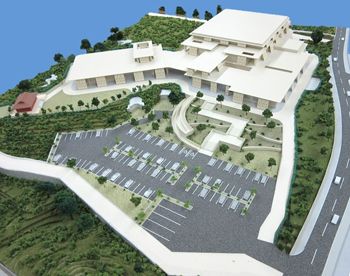
August 5, 2016 Ryukyu Shimpo
The International Olympic Committee (IOC) has determined that among four other sports, a karate event will be added to the 2020 Tokyo Olympic Games. Due to the influx of karate practitioners and enthusiasts who will be traveling from around the world to Okinawa , which Karare originated in, it is likely that Okinawa will experience an economic ripple effect. Based on the new Okinawa Karate Kaikan set to be opened in March 2017, the Okinawa Prefectural Government (OPG) is looking to call karate lovers from around the world to Okinawa next year in order to promote the popularity of karate as its tourism asset both domestically and overseas.
There were 411 karate dojos in Okinawa as of 2014, and throughout that year 674 people came to Okinawa for purposes related to karate, according to the OPG. However, there are many cases in which the reasons for people’s travels are difficult to grasp, so the OPG believes that the real numbers are considerably higher. In the past few years the number of people coming to Okinawa for purposes pertaining to karate has increased, and it is likely that this tendency will continue from now on.
Going forward, it is also anticipated that private sector businesses will develop and promote products aimed at travelers visiting the birthplace of karate, and a rise in opportunities to further pass down and develop the karate tradition appears promising.
According to the Japan Karate Federation, there are currently about 100,000,000 karate practitioners and enthusiasts in 192 countries throughout the world. Karate lovers from around the world often stay in Naha City, sometimes for consecutive days, to visit Shureido, a famous manufacturer of karate garb and equipment. A Shureido staff member says that on many days only foreigners will enter the store in dozens and request to buy karate gear, and that it can be expected that the number of karate lovers coming to Okinawa will increase with the Olympic event that is scheduled.
President of the Okinawa Convention and Visitors Bureau, Chokei Taira, says that, “The adoption of karate as an event in the Olympics is a good chance for Okinawa to gain recognition as the birthplace of karate.” He anticipates that karate may earn a spot as a sport in Okinawa advocated by MICE (meetings, incentives, conventions, and exhibitions), an online tool to attract tourists and facilitates travel planning.
Director the Ryugin Research Institute, speaking about the potential for an economic ripple effect, says that people come to Okinawa every year to study with karate masters and compete in tournaments. In many cases families accompany these visitors. With the increase expected due to the Olympic event, and if karate lovers and their families stay one or two weeks at a time, he thinks the ripple effect could indeed be considerable.
(English translation by T&CT and Erin Jones)
Go to Japanese
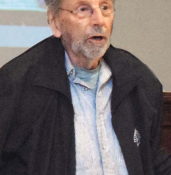
August 16, 2016 Ryukyu Shimpo
Sakae Toiyama reports from Washington DC
On August 14 at the 31st annual convention of the Veterans for Peace (VFP), a representative of the Ryukyu-Okinawa Chapter Douglas Lummis, and an associate of the same chapter Yoshikazu Makishi called for the VFP members to support retraction of the plan to relocate Futenma Air Station to Henoko.
Lummis reported that candidates who approve of the plan to relocate Futenma Air Station to Henoko are unable to win in Okinawa. To support this point, he mentioned the results of the Okinawa gubernatorial election, the Nago mayoral election, and the House of Councillors Okinawa district seat election.
Makishi talked about the construction of new helipads around Higashi Village, Takae that are precursors for returning a portion of the Northern Training Area to the Japanese government. He reported on the environmental destruction and protest movement related to this construction.
In Decemeber last year, Tarak Kauff of the VFP’s board of directors and VFP member Mike Hanes came to Okinawa to make a report on the condition of Okinawa at that time. Kauff announced that the VFP had been successful in establishing a chapter for Okinawa, and emphasized the importance of solidarity with the prefecture. Hanes touched on the violence of the US military at the time of the 1995 rape incident, which occurred while he was a Marine stationed in Okinawa. Speaking on this topic, he declared that nothing is born of violence.
On the last day of the VFP annual convention, members of the Ryukyu-Okinawa Chapter attended the closing ceremony, and held a discussion with a citizen’s group in San Francisco, before departing.
(English translation by T&CT and Erin Jones)
Go to Japanese
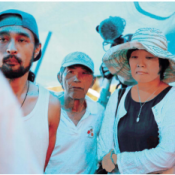
August 7, 2016 Ryukyu Shimpo
On August 6, the prime minister’s wife, Akie Abe, visited a sit-in protestors’ tent at the N1 rear gate of the Northern Training Area set up in opposition to helipad construction. She listened to the protestors explain the sit-in site. The protestors showed bewilderment at her unexpected visit.
In July, Mrs. Abe came to Okinawa to give a speech in support of Aiko Shimajiri in her campaign for an Okinawa district seat in the House of Councillors. Shimajiri is an LDP politician who supports helipad construction and the relocation of Futenma to Henoko. Some of those protesting criticized the first lady for this, asking what it was she came to Takae to accomplish. Others wanted her to convey the hardships facing Okinawa to the prime minister.
Yohei Miyake, a musician and two-time candidate for the House of Councillors, said that First Lady Akie Abe was inspired to see Takae for herself when she watched the documentary Hyoteki no Mura (Targeted Village), which depicts the issue of helipads in Takae. Although Miyake had spoken about this to Hiroji Yamashiro, chairman of the Okinawa Peace Movement Center, he did not notify the majority of Okinawans about the first lady’s visit. This explains their voiced bewilderment and doubt at her sudden appearance.
Mrs. Abe accompanied Miyake into the protest tent and listened to Okinawans talk about the protest movement, but she did not state her opinion.
Chie Miyagi brought up base burden issues to the first lady, such as late-night Osprey flights and the case of assault and murder by a US base employee. Mrs. Abe simply nodded and gave Miyagi her business card. Miyagi voiced her hope that the first lady will tell the prime minister about Okinawans’ hardships, and mentioned that Mrs. Abe thanked her for the experience.
Director of the Okinawa Peace Movement Center Satoru Oshiro shared his negative viewpoint on the implications of the first lady’s visit, as her husband is trying to force through base construction:
“She is different from a citizen [of Japan]. For her to say ‘I came because I want to see,’ is suspicious. It will be good if she listens to the voices of protesting Okinawans and conveys the current status of Okinawa to the prime minister. However, that is probably not the case.”
(English translation by T&CT and Erin Jones)
Go to Japanese
August 4, 2016 Ryukyu Shimpo
On August 3 in Rio de Janeiro, Brazil, the International Olympic Committee (IOC) held a meeting and voted to add 18 events in five new sports including Karate, which originated in Okinawa, to the next Olympics to be held in Tokyo 2020. Baseball, softball, skateboarding, surfing, and climbing will also be added. It will be the first time Karate has featured at the Olympics.
The IOC voted by a show of hands and reached a unanimous decision. It is the first time ever for a host city to introduce new sports to the Games.
The IOC President Thomas Bach said the change to the Olympic program is groundbreaking.
For karate, there will be a total of eight events including “kata” by gender, and three levels of “kumite” by gender. Receiving the news, Okinawa Karatedo Federation held a press conference on August 4 at Okinawa Amateur Sports Association Hall. The All Japan Karatedo Federation also held a press conference on August 4, and Ryo Kiyuna from Okinawa joined the conference.
Medalist from Okinawa
President Koei Teruya of Okinawa Karatedo Federation said, “Okinawan karate practitioners’ competitiveness will improve by the time of the Tokyo Olympics. Karate is a treasure of Okinawa. We will push for rules to be defined clearly and we will aim to develop instructors and players. The Federation will support practitioners from Okinawa as they strive to get to the Tokyo Olympics to win a medal.”
To represent Japan
Ryo Kiyuna (Ryueiryu Ryuhoukai), who reached the top of “kata” at the KARATE 1 Premium League Okinawa and All Japan Championship said, “It was my dream from childhood to compete in karate at the Olympics. I will practice harder to be chosen as a Japanese representative for the Tokyo Olympics.”
(English translation by T&CT and Megumi Chibana)
Go to Japanese
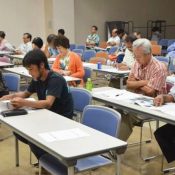
July 31, 2016 Ryukyu Shimpo
An association representing people involved in the Okinawan fishing industry who oppose construction of a new U.S. base in Henoko, Nago, held a regular general meeting in Uruma City on July 30. The association unanimously passed a special resolution seeking the withdrawal of the U.S.Marine Corps from Okinawa and the halting of construction of the new base in Henoko and helipads in Takae, Higashi Village.
In the wake of the rape and murder of a woman by a U.S. military contractor, the association added to the resolution the call to withdraw U.S.Marine Corps from Okinawa. Co-director of the association Zinsei Nishime said, “This is the first time the association has called for the withdrawal of U.S.Marine Corps from Okinawa. Unless this happens, there will be no way to guarantee that there won’t be a recurrence of tragic crimes and accidents involving the U.S military.”
The association was set up in May 2015. At the meeting, the association members reported several projects involving fixed-point observation of coral reef for the fiscal year of 2015. They confirmed that they would continue opposing new base construction in Henoko.
Another co-director of the association Tadashi Oshiro said, “We can’t avoid the issues of Henoko and Takae. We will do our best to make the sea in Okinawa peaceful and prosperous.”
The East Asian Community Institute, for which former Prime Minister Yukio Hatoyama is president, will display the resolution in English at a photo exhibition about issues related to the Henoko relocation, which will be held in Berkeley, California on August 11.
(English translation T&CT)
Go to Japanese
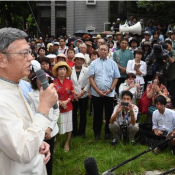
August 6, 2016 Ryukyu Shimpo
On August 5, the first hearing in a new lawsuit brought by the Japanese government against Okinawa Prefecture was held at the Naha branch of the Fukuoka High Court. The lawsuit is an “action for the declaration of illegality of inaction;” the government wants the court to rule that Governor Takeshi Onaga’s nullification of the permit authorizing the reclamation of land in Henoko, Nago, and his refusal to comply with an order to undo the nullification, were illegal. Meanwhile, Okinawa Prefecture holds that the nullification was legal, and that its refusal to obey the “rectification order” by the national government demanding that it revoke the nullification does not constitute illegal “inaction.” The national government submitted a written statement requesting that the trial be concluded on the same day it began, in contrast to which Governor Takeshi Onaga, in his testimony, called for “a thorough inquiry” into the case. Okinawa Prefecture applied to have eight witnesses take the stand, including experts on biological ecosystems and national security, as well as Nago Mayor Susumu Inamine, but presiding judge Toshiro Tamiya only authorized testimony to be given by Governor Onaga himself, and announced that the trial will conclude on August 19. A verdict is to be made on September 16.
In his opening testimony, Governor Onaga referred to the fact that the Committee for Settling National-Local Disputes, which had been tasked with reviewing the validity of the government’s rectification order, announced in June that it was unable to reach a verdict and instead called on both sides to engage in “earnest discussions.” In regard to this, Onaga said, “It is unfortunate that the situation has devolved into a lawsuit [without engaging in discussion].”
Onaga further stated, “Is there any region besides Okinawa that is so unilaterally persecuted by our own government? Okinawa is only one of Japan’s forty-seven prefectures, yet the government is attempting with all its might to wrest Okinawa into submission.”
Ministry of Justice Litigation Bureau chief Makoto Jozuka, representing the government side, emphasized that all opinions had been aired regarding the nullification of the land reclamation authorization during the trial for the “execution by proxy lawsuit” brought against Okinawa by the government last year. “We want the court to conclude the trial and reach a verdict quickly,” Jozuka said.
In his testimony, Governor Onaga explained that the Henoko land reclamation plan entails “tremendous disadvantages,” including the loss of Okinawa’s unique and precious natural and environmental resources. He also argued that the plan would entrench the excessive burden of U.S. bases borne by Okinawa. Onaga stated that the reasons given by the government to explain the necessity of the land reclamation “are not found to imply any specific public benefit or necessity justifying the considerable disadvantages” that the land reclamation would entail, and emphasized that his nullification of the authorization was legal and within the scope of his discretionary powers. The national government, meanwhile, argued in its written complaint that there were no legal flaws in the previous governor’s authorization of the land reclamation, and that in authorizing the land reclamation, “[previous governor Nakaima] did not overstep his discretionary powers.”
(English translation by T&CT and Sandi Aritza)
Go to Japanese
August 4, 2016 Ryukyu Shimpo
On August 3, the Okinawa Prefectural Government submitted written statements to the Fukuoka High Court from Governor of Okinawa Takeshi Onaga and Mayor of Nago City Susumu Inamine. The statements relate to a case the central government brought against the prefectural government, contesting the legality of Governor Onaga’s nullification of the landfill permit that would accompany Futenma Air Station relocation to Henoko.
In his statement Onaga wrote that if the central government acts unlawfully, and all decisions come to be made on ideas at the national level, then local autonomy will become inert. He also mentioned that on the local level would remain tenaciously into Japan’s future.
Touched by the resurge of the resentment felt against incidents by U.S. military affiliated persons at the time of the incident of assault and murder by a U.S. base employee in May, Onaga affirmed that Okinawans will not allow themselves to be made scapegoats. He went on to present his vision of Okinawa’s future not as a position of defense, but as a bridge contributing peace and stability throughout East Asia. Furthermore, he called to attention that, “We must not give up on the natural way that we decide for ourselves things that are our own concerns.”
In relation to this lawsuit being brought to court, Onaga pointed out the concluded suggestion from the Committee for Settling National-Local Disputes for a meeting, saying, “As long as a meeting cannot be convened, there is no indication of how to correct [this situation], or even assess the validity of [this lawsuit].” in response to the government’s hasty lawsuit he asked, “Should [the central government] not be faulted for ignoring the Committee’s conclusion?”
Mayor Inamine explained the circumstances surrounding the construction of a new base in Henoko, the effects it will have on the environment, and similar details. Inamine brought up the current issue of Okianwa’s concentration of military bases, touching on the Japanese Navy’s Vice-Admiral Minoru Ota’s words during wartime Okinawa. Ota asked that Okinawans be given special consideration from that day (June 6, 1945) forward, due to the suffering they had endured during the Battle of Okinawa.
(English translation by T&CT and Erin Jones)
Go to Japanese
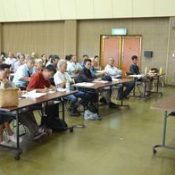
July 25, 2016 Ryukyu Shimpo
On July 24, the newly-formed “Nuchi du takara (life is a treasure)! Ryukyu self-determination association (preparatory association)” held an event to celebrate its formation at the Central Community Center in Nishihara Town. Approximately 150 people attended the event. The association aims to be a “civil society-style political organization” and plans to utilize the United Nations and international law to work toward realizing self-determination, with an eye on the possibility of eventually achieving Ryukyuan independence. The association plans to develop into an official political association once it attains a certain number of supporters.
The association upholds five tenets, including “embodying the history of Ryuku/Okinawa up until the present, and, with strength, opening up the future through the exercise of Ryuku/Okinawan self-determination with a readiness to aim for independence,” and “bidding farewell to the colonialism of Ryukyu/Okinawa by Japan and the United States, which continues today in the form of the Henoko new base construction issue.” Members are required to have roots in the Ryukyu arc.
As its basic policy, the association upholds the goals of “working together with the United Nations, international society, and East Asia and expanding self-determination” and “seeing resolutions supporting the realization of self-determination passed by all of [Okinawa’s] city, town, and village assemblies, and by the Prefectural Assembly.” It plans to work on a variety of pressing issues, including working to achieve the immediate closure of U.S. Marine Corps Air Station Futenma, opposing the forcible construction of a new base in Henoko and of Osprey pads in Takae, and opposing increased Japan Self-Defense Force deployment on Okinawa and further militarization of Okinawa, in addition to working to promote economic development, cultural promotion, language education, and an improved working environment.
One sponsor of the association, Nishihara Town councilmember Yoshio Yonamine, said, “Ultimately, we hope to become a group capable of conducting a prefectural referendum on the issue of realizing self-determination.”
(English translation by T&CT and Sandi Aritza)
Go to Japanese
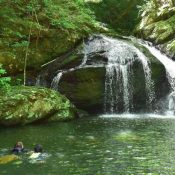
July 28, 2016 Ryukyu Shimpo
By Chie Tome and Chosho Yakabe
The forest in Yambaru, where the U.S. and Japanese governments plan to build new military helipads, is one of Japan’s most treasured nature spots home to more than six thousand kinds of rare and new species of animals and plants. Led by Yambaru butterfly researcher Akino Miyagi, we walked along Arakawa gawa in Higashi Village and Fun gawa in Kunigami Village. These natural wonders stretch along the forest, as if refusing to be changed by human hands.
Arakawa gawa is located a few kilometers from the N1 section of the U.S. Military Northern Training Area.
A semi-endangered species, Rhabdoblatta, is waiting for right time to hatch its eggs. On a tree branch, Japalura polygonata polygonata is trying to conceal itself.
Fun gawa is located near the LZ1 area, where low-level flight training has been carried out. A semi-endangered species if butterfly, Pithecops corvus, flutters around our legs and an Okinawa woodpecker and Ryukyu robin sing away somewhere in the background. A 20-centimeter long Dolomedes orion clings onto a rock face, and Himehabu (Ovophis okinavensis) takes a nap under the shade of a rock. On the tip of a big leaf, you can see a couple of Coeliccia ryukyuensis ryukyuensis mating.
As Miyagi points out a Ryukyu Leopard plant (Farfugium japonicum var. luchuense), she reflects, “Development constructions and low-level flight training have a tremendous impact on plants and animals. Before it’s too late, I hope people will realize that people are also kept alive by this Yambaru forest.”
(English translation by T&CT and Megumi Chibana)
Go to Japanese
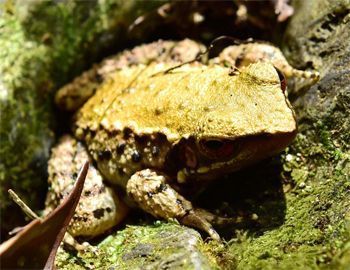
On July 2, around the Arakawa gawa in Takae, Higashi Village, a species of frog endemic to Yambaru.
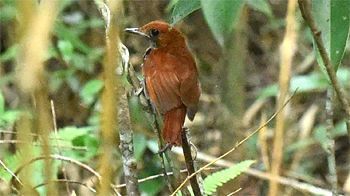
On June 25, around Fun gawa in Kunigami Village, a national treasure species Ryukyu robin sings in the forest.
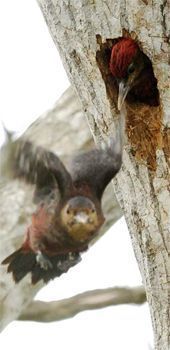
In May 2014, the Yambaru forest is known to be a habitat of endangered natural species Okinawan woodpecker (Photograph taken by Masatoshi Moromizato).
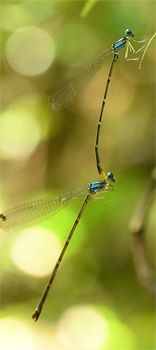
< Coeliccia ryukyuensis ryukyuensis> On June 25 around Fun gawa in Kunigami Village, a couple of Coeliccia ryukyuensis ryukyuensis take a break on a leaf.
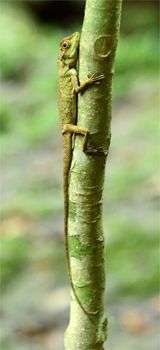
On July 2, around Arakawa gawa in Takae, Higashi Village, an Okinawa tree lizard puts up guards and merges with a branch.
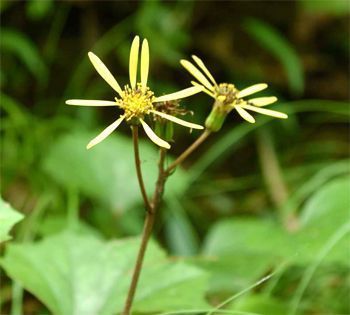
On June 25 around Fun-gawa, Kunigami Village, a small yellow Ryukyu Leopard plant blooms by the river.
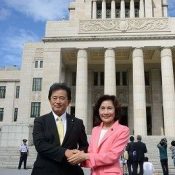
August 1, 2016 Ryukyu Shimpo
[Tokyo] On the morning of August 1, Yoichi Iha, who was recently elected to represent Okinawa in the House of Councillors, attended his first Diet session. With a look of determination on his face, Iha said, “It is a heavy responsibility to become a Diet member at this crucial moment, when the Okinawa issue and so many other challenges are facing us.” He discussed his resolve to convey the will of Okinawans on the Diet floor, including opposition to the relocation of U.S. Marine Corps Air Station Futenma to Henoko, Nago, and to the planned construction of helipads in exchange for the return of a part of the U.S. military’s Northern Training Area.
After attending the Diet session, Iha exchanged a firm handshake with fellow House of Councillors member Keiko Itokazu. Iha and Itokazu have formed a faction within the House of Councillors called “Okinawa Whirlwind,” which will belong to the House of Councillors Committee on Foreign Affairs and Defense and Committee on Judicial Affairs. Iha will be on the Committee on Foreign Affairs and Defense. Iha pointed out that people are not sufficiently aware of the ways in which Okinawan human rights and property rights are being infringed upon by the bases. “Ignoring the will of the Okinawan people and pushing forward with the [construction of] military facilities will damage the U.S.-Japan security alliance and Japan’s national security. I want to start by getting people to learn about the real situation in Okinawa,” Iha said with intensity. Iha was seen off to the Diet session by his wife, Nariko, and his son, Shunsuke.
(English translation by T&CT and Sandi Aritza)
Go to Japanese
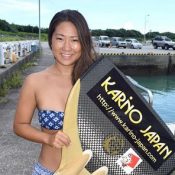
August 2, 2016 Ryukyu Shimpo
On August 1, Sayuri Kinoshita, a 27-year-old world record-holding free diver from Nagasaki, went free diving in Oura Bay, Henoko. Her diving took her into underwater caves and similar places at Ino, Henoko, and two other locations. Although she has been diving in oceans all around the world, in regard to Oura Bay she said, “[It has] many living creatures and small fish in calm and gentle waters.”
Kinoshita has been diving in oceans throughout the world, such as the Caribbean Sea around Central and South America and the Mediterranean Sea. She has been practicing free diving at Cape Maeda in Onna Village, but this was the first time she had been diving on the east side on Okinawa Island. According to Osamu Makishi, a boatman familiar with the area, this time of year there is a lot of plankton and the water is cloudier than usual. However, Kinoshita was left with a deep impression as, “The light visible from the caves, shining through the clear water was very beautiful.”
In regards to the land-reclamation project in Henoko for the purpose of relocating Futenma Air Station, Kinoshita said, “it is simply a waste.” She went on to say, “Nature that took 500 or 600 years to flourish will take only an instant to be destroyed.” To emphasize her point she explained, “[That nature] cannot easily be recovered; it will take time.”
(English translation by T&CT and Erin Jones)
Go to Japanese















 Webcam(Kokusai Street)
Webcam(Kokusai Street)


